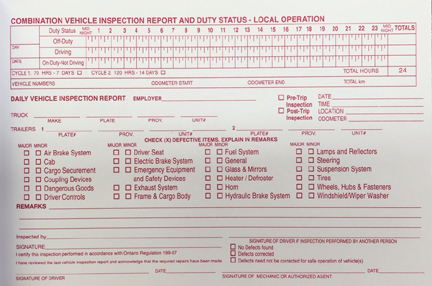
Daily (pre-trip) inspections
The purpose of the daily vehicle inspection is to ensure that problems and defects have been identified before the vehicle is operated on the highway. Inspections prevent the operation of a vehicle with problems that are likely to cause or contribute to the severity of an accident.
HTA Regulation 199/07 contain the requirements for daily (pre-trip or “circle check”) inspections that must be completed within 24 hours before driving.
Vehicles that require daily inspections
- trucks, trailers and converter dollies, on their own or in combination, with a total gross weight or registered gross weight of more than 4,500 kg
- buses designed to transport 10 or more passengers, and any trailer towed by one of these vehicles
- accessible buses modified to be used to transport persons with disabilities, if not being used for personal purposes only, and every trailer towed by one of these vehicles
- school-purposes vehicles and buses operating under contract with a school board or other authority in charge of a school being used for the transportation of 6 or more children or adults with a developmental disability
How daily inspections work
- the vehicle is inspected before it is driven
- the inspection is conducted with the use of a schedule listing the vehicle components and systems that require inspection
- an inspection report is completed
- the inspection and report are valid for 24 hours
- the driver carries the inspection schedule and report in the vehicle
- the driver records on the report any defects found while en route and at the end of the trip or day
- the driver reports defects to the operator at the time they are discovered – the operator must repair the defect immediately, or before the next dispatch, and keep records of repair
How to complete a daily inspection:
You may choose an inspection procedure (circle procedure or walk-around) that best suits your vehicle and its location. No matter which order of items you choose, you must inspect each item on the applicable inspection schedule.
You must record any defects you discover on the inspection report and notify the operator about them. You must carry and produce an inspection schedule based on your vehicle, as well as a corresponding valid inspection report.
- if you find no defect on the vehicle, as defined in the inspection schedule, then “no defect” is recorded, and the inspection is valid for 24 hours.
- if you find a “minor” defect on the vehicle, as defined in the inspection schedule, the defect must be recorded and reported to the operator as soon as possible. The operator is required to repair any defects that do not meet the performance standards. The inspection is valid for 24 hours.
- If you find a major defect on the vehicle, as defined in the inspection schedule, the vehicle cannot be operated. You must record the defect, report it to the operator immediately, and the vehicle must be repaired prior to being driven.
If a defect as defined in the inspection schedule is identified after the inspection is completed, the defect must also be recorded and reported to the operator. Should the identified defect be a major defect, you must stop operating the vehicle until it is repaired.
Commercial Vehicle Operator’s Safety Manual, Module 8: Preventative Maintenance, Record-Keeping and Vehicle Files

Recent Comments